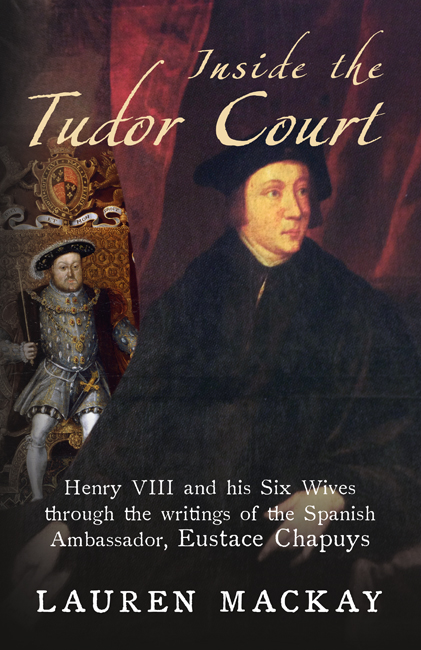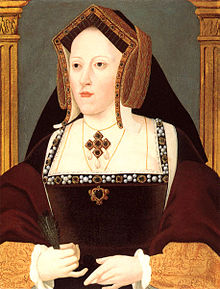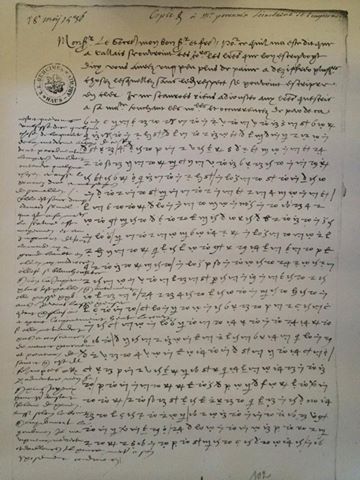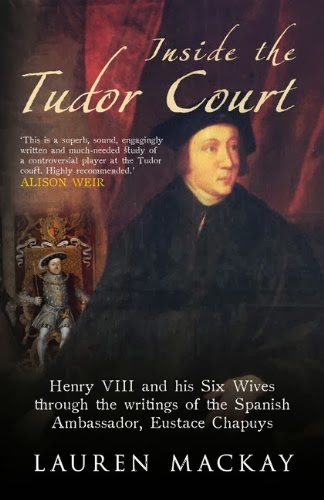 Just how instrumental was the Spanish ambassador Eustace Chapuys in colouring our modern perceptions of Henry VIII and his wives? He spent sixteen years at the Tudor court as the ambassador for Spain, a career which observed all six of Henry’s wives and his three heirs. He fought a downhill battle in “The King’s Great Matter” and watched Katherine of Aragon put aside and die, alone and abandoned. He worked tirelessly to preserve the position of Henry VIII’s and Katherine’s daughter, Mary Tudor. Chapuys’ observations are so heavily relied upon by historians his perceptions have seeped into popular culture. We know him for his acerbic wit. Beneath the barbs, however, are some of the most enlightening representations of the Tudor Court we have today. His observations of Anne Boleyn have made him one of her most valuable biographers, and a contemporary advocate of her innocence.
Just how instrumental was the Spanish ambassador Eustace Chapuys in colouring our modern perceptions of Henry VIII and his wives? He spent sixteen years at the Tudor court as the ambassador for Spain, a career which observed all six of Henry’s wives and his three heirs. He fought a downhill battle in “The King’s Great Matter” and watched Katherine of Aragon put aside and die, alone and abandoned. He worked tirelessly to preserve the position of Henry VIII’s and Katherine’s daughter, Mary Tudor. Chapuys’ observations are so heavily relied upon by historians his perceptions have seeped into popular culture. We know him for his acerbic wit. Beneath the barbs, however, are some of the most enlightening representations of the Tudor Court we have today. His observations of Anne Boleyn have made him one of her most valuable biographers, and a contemporary advocate of her innocence.
Inside the Tudor Court: Henry VIII and his Six Wives through the Life and Writings of the Spanish Ambassador, Eustace Chapuys is a remarkable book about a remarkable man. A veritable treasure trove of rarely seen letters which gives us a fresh insight into the most notorious King of England, Henry VIII, and his six wives, it also paints a detailed portrait of the usually elusive Spanish ambassador. Historian Lauren Mackay joins us to discuss her new biography of one of our most important sources of the reign of Henry VIII, Eustace Chapuys.
Can you describe Chapuys’ actual ambassadorial mission when he first arrived at the Tudor court?
Chapuys’ instructions included maintaining trade, and other financial concerns. However he was also faced with an impossible task. Firstly, his mission was to represent Katherine of Aragon and argue her case. Charles had chosen Chapuys for this particular mission because of his legal training and experience. But he was also instructed to promote good relations with Henry, and most importantly, keep France out of England’s bed.
Chapuys was plunged straight into what we might consider an ‘enemy camp’. Can you tell us about who he encountered when he first arrived at the Tudor court and his first meeting with Henry VIII?
Some of the first men Chapuys met included Thomas Howard Duke of Norfolk, and Thomas and George Boleyn. He was more concerned that he would not be welcome, and did his best to make a good impression. Above all, he thought it more beneficial to work with these men. He found the Boleyn men to be intelligent, affable and approachable.

You said that Chapuys became the head of what we now call the ‘Aragonese faction’. Considering Charles V was keeping his distance from the issue of the annulment was this a point where Chapuys was becoming more personally involved of his own accord?
Absolutely, he saw Katherine isolated, and neglected by Charles and Henry. He felt the need to step forward and fight her battles, sometimes to his own political detriment. His dedication to Katherine saw him lock horns with Henry and various advisors, but he would not abandon her.
Katherine of Aragon always seemed convinced that the removal of Anne Boleyn would solve her marriage issues, do you think Chapuys also believed this?
At first, I believe Chapuys did hope Anne Boleyn would lose her grip on the king, but he very soon acknowledged that Henry would never return to Katherine. Instead, Chapuys the lawyer worked to secure the best settlement for his client. He often wrote to Charles and his old friend, de Granvelle, that he could not convince her that Henry was beyond the point of no return.
You said that by 1535 Chapuys and Katherine of Aragon had two very different mindsets in regards to Princess Mary. How integral was Chapuys to Mary’s survival at this point, if survival is not too dramatic a word?
Henry was unpredictable. I don’t believe survival is too dramatic a word, Henry was determined to beat Mary into submission, and he had a habit of responding with violence. Katherine seemed set on joint martyrdom, but Chapuys thought only of Mary’s survival, even if it meant sacrificing her title.
 Chapuys is largely known for his alleged hatred of Anne Boleyn, how do you think this has coloured our perception of him?
Chapuys is largely known for his alleged hatred of Anne Boleyn, how do you think this has coloured our perception of him?
Chapuys has been erroneously maligned for his opposition to Anne, and his reputation and character are now twisted into something dark, insidious, and misogynistic. This is far from the truth. Chapuys referred to Anne as the concubine once in 1533, and then more frequently from 1535, but more often than not he referred to her as Lady Anne, or Marchioness. The Anne of his original letters is perhaps more human than depictions in popular fiction. It’s too easy to perpetuate the outdated myth that Chapuys was violently opposed to Anne and her family, and would stop at nothing to bring her down. The image Chapuys’ letters left me with was a man opposed to an ambitious woman, but who felt so strongly about her arrest and execution that he was willing to tell Charles V, the most powerful man in Europe: What Henry has done here is unconscionable. Her execution weighed heavily on his mind in the weeks following that bloody May.
What do you think our knowledge of Anne Boleyn would be like without Chapuys’ observations of the Tudor court?
Lacking texture. Right now Anne’s reputation suffers from either a demonisation or hagiograhical approach. Chapuys showed her humanity: her insecurity, impatience with Henry and the never ending divorce trial, fights with her father, close (and absolutely platonic) love for her brother, fiery temper and of course ambition.

Chapuys had a very emotional reaction to the death of Katherine of Aragon, but he also seems to have been sympathetic towards Anne and even emotional at Catherine Howard’s death. Do you think he was becoming sick of the Tudor court by the time Henry executed his fifth wife?
I think by Anne’s execution the court sickened him to a degree. No monarch had ever behaved as Henry behaved, and I think he longed for the structure of European courts. He no doubt wondered: where would it end? His first meeting with Henry, back in those innocent days of 1529, was cordial, jovial and seemed to promise a successful relationship. Chapuys’ last meeting in 1545 was, in contrast, cold, perfunctory, and showed just how far Henry had fallen in the ambassador’s esteem.
I think that everyone is fascinated by the relationship between Chapuys and Thomas Cromwell, can you tell us a little more about it?
Their relationship was complex. Both men of the world, they had travelled through the same places in Europe, and their intellectual circles overlapped. They served very different masters, and thus had competing agendas, but they were able to put these aside, and enjoy a meeting of minds.
Besides his integral observations of the Tudor court, what else makes up Eustace Chapuys’ legacy?
Chapuys was an extraordinary intellectual and humanist, and he was dedicated to educating under privileged boys in his home town of Annecy, as well as Louvain, where he retired. He had a close and enduring relationship with Erasmus, and showed himself to be part of these broad humanist networks.
Would you like to tell us about what you’re working on next?
I am currently completing my PhD thesis on the Boleyn men, but I am currently researching for my next book, which will be a biography of Thomas Howard, the Duke of Norfolk.
With thanks to Amberley Publishing
 Lauren Mackay is an historian whose focus of study goes beyond familiar historical figures and events to lesser known individuals, as well as beliefs, customs, and diplomacy of the 16th Century.
Lauren Mackay is an historian whose focus of study goes beyond familiar historical figures and events to lesser known individuals, as well as beliefs, customs, and diplomacy of the 16th Century.
Lauren completed her Master of History with University of New England, and is currently researching her PhD on Thomas and George Boleyn in the English Reformation, with University of Newcastle in Australia. Lauren has given several talks based on her research in the United Kingdom and Australia, and her debut book, ‘ Inside the Tudor Court: Henry VIII and his Six Wives through the Life and Writings of the Spanish Ambassador, Eustace Chapuys’ is out now.
Visit Lauren’s website at lauren-mackay.com
Lauren on Twitter
Lauren on Facebook Inside the Tudor Court

Inside the Tudor Court: Henry VIII and His Six Wives Through the Writings of the Spanish Ambassador Eustace Chapuys by Lauren Mackay, published by Amberley Publishing 2014.
The reports and despatches of Eustace Chapuys, Spanish Ambassador to Henry VIII’s court from 1529 to 1545, have been instrumental in shaping our modern interpretations of Henry VIII and his wives. As a result of his personal relationships with several of Henry’s queens, and Henry himself, his writings were filled with colourful anecdotes, salacious gossip, and personal and insightful observations of the key players at court, thus offering the single most continuous portrait of the central decades of Henry’s reign. Beginning with Chapuys’ arrival in England, in the middle of Henry VIII’s divorce from Katherine of Aragon, this book progresses through the episodic reigns of each of Henry’s queens. Chapuys tirelessly defended Katherine and later her daughter, Mary Tudor, the future Mary I. He remained as ambassador through the rise and fall of Anne Boleyn, and reported on each and every one of Henry’s subsequent wives – Jane Seymour, Anne of Cleves, Catherine Howard, and Katharine Parr – as well as that most notorious of ministers Thomas Cromwell. He retired in 1545, close to the end of Henry VIII’s reign. In approaching the period through Chapuys’ letters, Lauren Mackay provides a fresh perspective on Henry, his court and the Tudor period in general.



